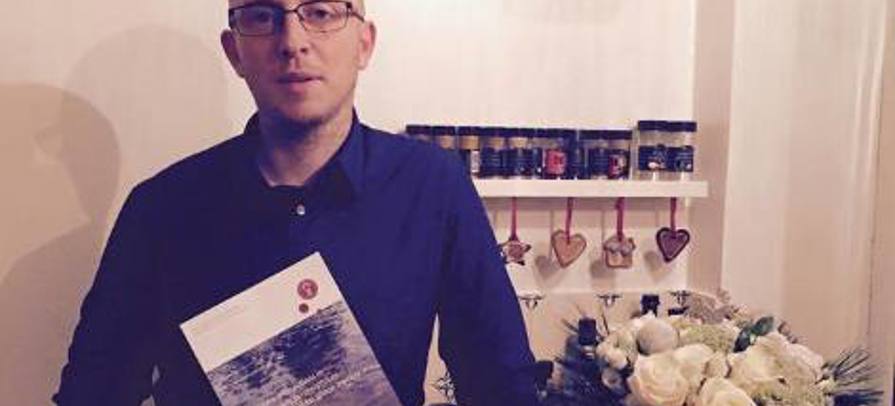Rói H. Christiansen vart ph.d. á Københavns Universitet
16. desember 2014 vardi Rói Hammershaimb Christiansen ph.d.ritgerð sína við Biologisk Institut á Københavns Universitet. Heitið á ritgerðini er: ”Phage-host interactions in Flavobacterium psychrophilum and the potential for phage therapy in aquaculture.”
Rói hevur við sínum verkætlan verið knýttur at bæði Marinbiologisk Sektion á Københavns Universitet og Veterinærinstituttet á Danmarks Tekniske Universitet. Umframt universitetini hava Chr. Hansen A/S, BioMar A/S, Aquasearch og Dansk Akvakultur verið við í verkætlanini.
Vegleiðarar hansara hava verið Mathias Middelboe, professari á Biologisk Institut, Københavns Universitet, og Lone Madsen, seniorgranskari á DTU Vet.
Í ritgerðini var ein synopsis (innleiðing) og fýra greinar, har tríggjar vóru útgivnar í altjóða tíðarritum og tann fjórða er send inn.
Í metingarnevndini vóru:
Lasse Riemann, lektari á Københavns Universitet, formaður
Michiel Vos, lektari, Exeter University
Lotta-Riina Sundberg, lektari, University of Jyväskylä
Verjan var almen og byrjaði við, at Rói helt ein fyrilestur í 45 minuttir, har høvuðsúrslitini í ritgerðini vóru løgd fram. Aftaná ein stuttan steðg sluppu opponentarnir framat og diskuteraðu ritgerðina við Róa úr enda í annan í hálvanannan tíma. Verjan gekk ógvuliga væl, og ph.d. heitið bleiv latið Róa við sera jaligum orðum frá metingarnevndini.
Høvuðsendamálið við ph.d. verkætlanini var at kanna møguleikan fyri at brúka bakteriofagar til at fyribyrgja og viðgera fiskasjúkuna YDS (yngeldødelighedssyndrom) í ælabogasíl yngli. Vaksandi trupulleikar við antibiotika mótstøðuføri hava viðført ein tørv á alternativum viðgerðarhættum og bakteriofag terapi hevur fingið meira og meira áhuga síðstu árini. Í ritgerðini verða interaktiónir millum bakteriofagar og bakteriur kannað in vitro við serligum atliti til menning av bakteriofagum mótstøðuføri. Eisini vóru genetiskar kanningar av mekanismunum handan bakteriofagt mótstøðuføri gjørdar, eins og royndir við ælabogasílum vóru gjørdar. Sí abstrakt frá ritgerðini á enskum longur niðri.
Stuðlað verkætlanini hava Directorate for Food, Fisheries and Agribusiness, the University of Copenhagen and the National Veterinary Institute, DTU Vet.
Les um Róa Hammershaimb Christiansen í Heilagrunninum
Abstract
The disease rainbow trout fry syndrome (RTFS) is caused by the bacterial fish pathogen Flavobacterium psychrophilum, which for decades has been the cause of great losses of rainbow trout in aquacultures both in Denmark and around the world. Disease outbreaks are typically seen at water temperatures below 15°C and typically with fry mortality rates of 50-60%. Several attempts of vaccine development against RTFS have been made, but according to our knowledge no commercial vaccine is yet available. Bacterial chemotherapy is still the most effective and used treatment of RTFS today. However, the increasing problem with antibiotic resistance has led to increased attention to the use of phages for controlling F. psychrophilum infections in aquaculture. In a synopsis and four scientific papers, this PhD project studies the potential and optimizes the use of phage therapy for treatment and prevention of F. psychrophilum infections in rainbow trout fry.
In the first paper, studies of the controlling effect of different phages infecting F. psychrophilum in liquid cultures showed that a high initial phage concentration was crucial for fast and effective bacterial lysis in the cultures and sensitive cells could be maintained at a low level throughout the rest of the experiment. Surprisingly, no difference was observed between infection with single phages or phage cocktails. At the end of incubation phage-sensitive strains dominated in the cultures with low initial phage concentrations and phage-resistant strains dominated at high initial phage concentrations. Isolated strains showed great phenotypic diversity and differences in resistance patterns against a range of phages. Furthermore, some of the strains showed reduced growth rates and reduced ability to utilize different substrates.
In the second paper, studies of the genetic diversity and susceptibility patterns of F. psychrophilum strains and phages isolated in three geographically distinct areas (Chile, Denmark, and USA) showed that the strains and phages clustered into geographically distinct groups. However, cross-infectivity between Chilean phage isolates and Danish host isolates and vice versa were found. Furthermore, the development of phage resistance against certain phages led to increased susceptibility to other phages in various F. psychrophilum groups, and in some cases this shift in sensitivity was associated with the loss of a specific pro-phage.
In the third paper, a detailed analysis of the resistance mechanisms in F. psychrophilum and six phage resistant mutants was done. The results revealed unique changes in the genomes in all the phage resistant strains and that some of these changes were related to cell surface properties which were suggested to be phage receptors. The observed links between phage resistance and the genetic modifications were supported by direct measurements of bacteriophage adsorption rates, biofilm formation and secretion of extracellular enzymes, which were all impaired in the resistant strains.
In the fourth paper, the dispersal and survival of a F. psychrophilum phage in vivo in juvenile rainbow trout after administration by three different methods was examined. Following phage administration by bath and oral intubation into the stomach, phages could be detected in the intestine, spleen, brain and kidney for 24 h before the phage concentrations started to decline. Continuous administration of phages via phage coated feed resulted in a constant abundance of phages in the intestine and the spleen throughout the experimental period. Furthermore, we documented that phages can tolerate long periods of desiccation on feed pellets. We suggest that continuous delivery of phages via coated feed pellets constitutes a promising method of treatment and especially prevention of rainbow trout fry syndrome.
Greinir
Castillo, D., Christiansen, R. H., Espejo, R., & Middelboe, M. (2014). Diversity and geographical distribution of Flavobacterium psychrophilum isolates and their phages: Patterns of susceptibility to phage infection and phage host range. Microbial Ecology, 67, 748-757.
Castillo, D., Christiansen, R. H., Dalsgaard, I., Madsen, L., & Middelboe, M. (2014). Bacteriophage resistance mechanisms in the fish pathogen Flavobacterium psychrophilum: Linking genomic mutations to changes in bacterial virulence factors. Applied and Environmental Microbiology, (in press).
Christiansen, R. H., Dalsgaard, I., Middelboe, M., Lauritsen, A. H., & Madsen, L. (2014). Detection and quantification of Flavobacterium psychrophilum specific bacteriophages in vivo in rainbow trout upon oral administration: implications for disease control in aquaculture. Applied and Environmental Microbiology, 80(24), 7683-93.
